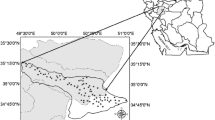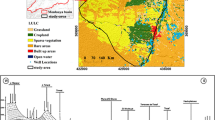Abstract
Increasing water shortages promote reclaimed water irrigation (RWI), which potentially causes additional contaminants in groundwater. The DRASTIC model has become an important tool to assess specific groundwater vulnerability. In this study, five parameters of the model were kept to calculated intrinsic vulnerability index (IVI). Aquifer media rating is calculated using the weighted average of ratings for all mediums instead of using the major medium rating, and the rating of the impact of vadose zone is adjusted for the clayey soils on the basis of their thickness. Subsequently, a single parameter sensitivity analysis is used to compute the effective weights of those five parameters. The Pearson’s correlation coefficient between IVI and Nemerow’s synthetical pollution Index (NI) of groundwater quality is significantly improved from 0.185 to 0.775 after four steps of revision. The RWI factor, Rrr, is introduced to assess specific vulnerability index (SVI) under RWI. The SVI decreases from east to west with the increases in depth to water, clayey soil thickness, and other factors. To manage contamination risk, the study area is divided into preferential zones, feasible zones and unfeasible zones for RWI planning and operation with suggested engineering measures.










Similar content being viewed by others
References
Al-Adamat RAN, Foster IDL, Baban SMJ (2003) Groundwater vulnerability and risk mapping for the Basaltic aquifer of the Azraq basin of Jordan using GIS, remote sensing and DRASTIC. Appl Geogr 23:303–324
Aller L, Bennett T, Lehr JH, Petty RJ, Hackett G (1987) DRASTIC: a standardized system for evaluating ground water pollution potential using hydrogeologic settings. EPA, Washington, EPA-600/2-87-035
Almasr MN (2007) Assessment of intrinsic vulnerability to contamination, for Gaza coastal aquifer, Palestine. J Environ Manag. doi:10.1016/j.jenvman.2007.01.022
Babiker IS, Mohamed MAA, Hiyama T, Kato K (2005) A GIS-based DRASTIC model for assessing aquifer vulnerability in Kakamigahara Heights, Gifu Prefecture, central Japan. Sci Total Environ 345:127–140
Bao C, Fang CL (2012) Water resources flows related to urbanization in China: challenges and perspectives for water management and urban development. Water Resour Manag 26(2):531–552
Candela L, Fabregat S, Josa A et al (2007) Assessment of soil and groundwater impacts by treated urban wastewater reuse. A case study: application in a golf course (Girona, Spain). Sci Total Environ 374:26–35
Chen XZ (2004) Soil mechanics and foundation engineering. Tsinghua University press, Beijing, pp 10–16
Chen LQ, Feng SY, Han ZW et al (2004) Preliminary evaluation of the shallow groundwater quality in Daxing district of Beijing city. China Rural Hydropower 5:23–24
Chen JY, Tang CY, Shen YJ et al (2005) Nitrate pollution from agriculture in different hydrogeological zones of the regional groundwater flow system in the North China Plain. Hydrogeol J 13:481–492
Chitsazan M, Akhtari Y (2009) A GIS-based DRASTIC model for assessing aquifer vulnerability in Kherran Plain, Khuzestan, Iran. Water Resour Manag 23:1137–1155
Dixon B (2005) Groundwater vulnerability mapping: a GIS and fuzzy rule based integrated tool. Appl Geogr 25:327–347
Evans BM, Mayers WL (1990) A GIS-based approach to evaluating regional groundwater pollution potential with DRASTIC. J Soil Water Conserv 45:242–245
Fritch TG, McKnight CL, Yelderman JC, Arnold JG (2000) An aquifer vulnerability assessment of the paluxy aquifer, central Texas, USA, using GIS and a modified DRASTIC approach. Environ Manag 25:337–345
Gogu RC, Dassargues A (2000) Current trends and future challenges in ground water vulnerability assessment using overly and index methods. Environ Geol 39(6):549–559
Hamza MH, Added A, Rodriguez R et al (2007) A GIS-based DRASTIC vulnerability and net recharge reassessment in an aquifer of a semi-arid region. J Environ Manag 84(1):9–12
Hooda AK, Weston CJ, Chen D (2003) Denitrification in effluent-irrigated clay soil under Eucalyptus globulus plantation in south-eastern Australia. For Ecol Manag 179:547–558
Ibe KM, Nwankwor GI, Onyekuru SO (2001) Assessment of groundwater vulnerability and its application to the development of protection strategy for the water supply aquifer in Owerri, southeastern Nigeria. Environ Monit Assess 67(3):323–360
Kass A, Gavrieli I, Yechieli Y et al (2005) The impact of freshwater and wastewater irrigation on the chemistry of shallow groundwater: a case study from the Israeli Coastal Aquifer. J Hydrol 300:314–331
Lazarova V (2001) Role of water reuse in enhancing integrated water management in Europe. Final report of the EU project CatchWater. ONDEO, Paris, 708
Li JZ (2009) An analysis of the coefficient of replenishment from infiltration of precipitation. Hydrogeol Eng Geol 2:29–33
Li FW, Feng P, Zhang W, Zhang T (2013) An integrated groundwater management mode based on control indexes of groundwater quantity and level. Water Resour Manag 27(9):3273–3292
Liu CL, Zhang Y, Ye H et al (2001) Obstraction of surface layer cohesive soil to municipal refuse pollutants in Pudong Shanghai. J Earth 22(4):360–368
Liu CL, Zhang Y, Ye H et al (2006a) Experimental studies of the filtration capability of clayey soils in the vadose zone and its influence on the evaluation of groundwater vulnerability to pollution(in Chinese). Acta Geosci Sin 27(4):349–354
Liu HH, Ding YY, Hao ZY, Wu WY et al (2006b) High water use efficiency in agriculture modernization (in Chinese). China Water Conservancy and Hydropower Press, Beijing, pp 6–9
Liu HH, Wu WY, Hao ZY et al (2006c) Water saving technologies for urban green spaces (in Chinese). China Water Conservancy and Hydropower Press, Beijing, pp 16–18
Margat J (1968) Vulnerabilite des nappes d’eau souterraine a lapollution [Ground water vulnerability to contamination] (in French). Bases de la cartographic, BRGM, 68 SGL 198 HYD, Orleans, France
Masetti M, Sterlacchini S, Ballabio C, Sorichetta A, Poli S (2009) Influence of threshold value in the use of statistical methods for groundwater vulnerability assessment. Sci Total Environ 407:3836–3846
Merchant J (1994) GIS-Based groundwater pollution hazard assessment: a critical review of the DRASTIC model. Photogr Eng Remote Sensing 60(9):1117–1127
Moody R, Ast JAV (2012) Implementation of GIS-based applications in water governance. Water Resour Manag 26(2):517–529
Napolitano P, Fabbri AG (1996) Single-parameter sensitivity analysis for aquifer vulnerability assessment using DRASTIC and SINTACS, HydroGIS 96: application of geographical information systems in hydrology and water resources management. Proceedings of Vienna Conference. IAHS Pub 235:559–566
Nemerow NL, Hisashi S (1971) Benefits of water quality enhancement. Syracuse University Syracuse NY. Report NO.16110DAJ. U.S Environmental Protection Agency, Washington
Nobre RCM, Filho OCR, Mansur WJ, Nobre MMM, Cosenza CAN (2007) Groundwater vulnerability and risk mapping using GIS, modeling and a fuzzy logic tool. J Contam Hydrol 94:277–292
Panagopoulos GP, Antonkos AK (2006) Optimizations of the DRASTIC method for groundwater vulnerability assessment via the use of simple statistical methods and GIS. Hydrogeol J 14:894–911
Papapetridis K, Paleologos EK (2012) Sampling frequency of groundwater monitoring and remediation delay at contaminated sites. Water Resour Manag 26(9):2673–2688
Pathak DR, Hiratsuka A, Awata I, Chen LN (2009) Groundwater vulnerability assessment in shallow aquifer of Kathmandu Valley using GIS-based DRASTIC model. Environ Geol 57:1569–1578
Pettygrove GS, Takashi A (1985) Irrigation with reclaimed municipal wastewater-a guidance manual. Lewis publishers. INC, London
Rahman A (2008) A GIS based DRASTIC model for assessing groundwater vulnerability in shallow aquifer in Aligarh, India. Appl Geogr 8:32–53
Secunda S, Collin ML (1998) Groundwater vulnerability assessment using a composite model combining DRASTIC with extensive agricultural land use in Israel’s Sharon region. J Environ Manag 54:39–57
Sorichetta A, Masetti M, Ballabio C, Sterlacchini S, Beretta GP (2011) Reliability of groundwater vulnerability maps obtained through statistical methods. J Environ Manag 92:1215–1224
Soutter M, Musy A (1998) Coupling 1D monte-carlo simulations and geostatistics to assess groundwater vulnerability to pesticide contamination on a regional scale. J Contam Hydrol 32:25–39
Su XS, Wang H, Zhang YL (2013) Health risk assessment of nitrate contamination in groundwater: a case study of an agricultural area in northeast China. Water Resour Manag 27(8):3025–3034
Thirumalaivasan D, Karmegam M, Venugopal K (2003) AHP-DRASTIC: software for specific aquifer vulnerability assessment using DRASTIC model and GIS. Environ Model Softw 18:645–656
Uricchio VF, Giordano R, Lopez N (2004) A fuzzy knowledge-based decision support system for groundwater pollution risk evaluation. J Environ Manag 73:189–197
US EPA (Environmental Protection Agency) (2004) Guidelines for water reuse. Agency for international development, Washington
US EPA(Environmental Protection Agency) (1993) A review of methods for assessing aquifer sensitivity and ground water vulnerability to pesticide contamination. U.S. EPA/813/R-93/002. EPA, Washington
Valentina L (2005) Water reuse for irrigation: agriculture, landscapes, and turf grass. Lewis Publishers, U.S., 20pp.
Verba J, Zaporozec A (1994) Guidebook on mapping groundwater vulnerability. Heinz and Heise Co, Hannover, pp 1–133
Vrana M (1984) Methodology for construction of groundwater protection maps. UNESCO/UNEP Project PLCE-3/29, Moscow
Wang JJ, He JT, Chen HH (2012) Assessment of groundwater contamination risk using hazard quantification, a modified DRASTIC model and groundwater value, Beijing Plain, China. Sci Total Environ 432:216–226
Wu WY (2009) Research on groundwater vulnerability experiment of reclaimed wastewater district and irrigation allocation (Doctoral dissertation). China University of Geoscience, Beijing
Zhong ZS (2005) A discussion of groundwater vulnerability assessment method. Earth Sci Front 12:3–11, China University of Geosciences, Beijing; Peking University
Acknowledgments
The study was funded by the national natural science funds 51339007 and Beijing Municipal Science & Technology Commission under grant number 2008B44.
Author information
Authors and Affiliations
Corresponding author
Rights and permissions
About this article
Cite this article
Wu, W., Yin, S., Liu, H. et al. Groundwater Vulnerability Assessment and Feasibility Mapping Under Reclaimed Water Irrigation by a Modified DRASTIC Model. Water Resour Manage 28, 1219–1234 (2014). https://doi.org/10.1007/s11269-014-0536-z
Received:
Accepted:
Published:
Issue Date:
DOI: https://doi.org/10.1007/s11269-014-0536-z




